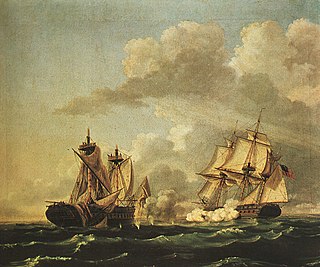Related Research Articles

HMS Macedonian was a 38-gun fifth-rate Lively-class frigate in the Royal Navy, later captured by the USS United States during the War of 1812.

The Evarts-class destroyer escorts were destroyer escorts launched in the United States in 1942–44. They served in World War II as convoy escorts and anti-submarine warfare ships. They were also known as the GMT or "short hull" DE class, with GMT standing for General Motors Tandem Diesel drive.

The Captain class was the designation given to 78 frigates of the Royal Navy, constructed in the United States, launched in 1942–1943 and delivered to the United Kingdom under the provisions of the Lend-Lease agreement. They were drawn from two classes of the American destroyer escort classification: 32 of the GMT (Evarts) Type and 46 of the TE (Buckley) Type. Upon reaching the UK the ships were substantially modified by the Royal Navy, making them distinct from the US Navy destroyer escort ships.
HMS Pegasus is the name which has been given to nine ships in the British Royal Navy. Pegasus was a winged horse in Greek mythology. These ships included:
Three ships of the Royal Navy have borne the name HMS Bentinck, named in honor of John Bentinck:
Four ships of the Royal Navy have borne the name HMS Amelia, whilst another was planned:

HMS Calder was a Captain class frigate of the Royal Navy during World War II. It was named after Admiral Sir Robert Calder, Bt. KCB, who was appointed Captain of the Fleet to Admiral John Jervis in 1796, and saw action at the battle of Cape St Vincent on 14 February 1797. Originally destined for the US Navy as a turbo-electric (TE) type Buckley-class destroyer escort, HMS Calder was provisionally given the name USS Formoe. However, the delivery was diverted to the Royal Navy before the launch.
Three ships of the Royal Navy have borne the name HMS Blackwood, after Vice-Admiral Sir Henry Blackwood:

HMS Berry (K312) was a Captain-class frigate, built in the United States as a Evarts-class destroyer escort, and transferred to the Royal Navy under the terms of Lend-Lease, which served in the Second World War. She was named after Rear Admiral Sir Edward Berry (1768-1831).
Several vessels of the Royal Navy have been named HMS Cockburn for Admiral Sir George Cockburn:
HMS Pitcairn (K589) was a Colony-class frigate of the United Kingdom that served during World War II. She originally was ordered by the United States Navy as the Tacoma-class patrol frigateUSS Pilford (PF-85) and was transferred to the Royal Navy prior to completion.
HMS Pasley (K564), ex-Lindsay, was a Captain-class frigate of the Evarts-class of destroyer escort, originally commissioned to be built for the United States Navy. Before she was finished in 1943, she was transferred to the Royal Navy under the terms of Lend-Lease, and saw service during the World War II from 1943 to 1945. She was the third ship of the Royal Navy to be named Pasley, after Admiral Sir Thomas Pasley (1734-1808), who commanded aboard his flagship HMS Bellerophon at the Glorious First of June in 1794.
HMS Essington may refer to more than one British ship of the Royal Navy:
HMS Cooke (K471) was a British Captain-class frigate of the Royal Navy in commission during World War II. Originally constructed as the United States Navy Evarts-class destroyer escort USS Dempsey (DE-267), she served in the Royal Navy from 1943 to 1946.
HMS Garlies (K475) was a British Captain-class frigate of the Royal Navy in commission during World War II. Originally constructed as the United States Navy Evarts-class destroyer escort USS Fleming (DE-271), she served in the Royal Navy from 1943 to 1945 and in the U.S. Navy as USS Garlies (DE-271) from August to October 1945.
HMS Goodall (K479) was a British Captain-class frigate of the Royal Navy in commission during World War II. Originally constructed as the United States Navy Evarts-class destroyer escort USS Reybold (DE-275), she served in the Royal Navy from 1943 until her sinking in 1945.

HMS Grindall (K477) was a British Captain-class frigate of the Royal Navy in commission during World War II. Originally constructed as the United States Navy Evarts-class destroyer escort USS Sanders (DE-273), she served in the Royal Navy from 1943 to 1945 and then in the U.S. Navy as USS Grindall (DE-273) from August to October 1945.
HMS Keats (K482) was a British Captain-class frigate of the Royal Navy in commission during World War II. Originally constructed as the United States Navy Evarts-class destroyer escort USS Tisdale (DE-278), she served in the Royal Navy from 1943 to 1946.
HMS Kingsmill (K484) was a British Captain-class frigate of the Royal Navy in commission during World War II. Originally constructed as the United States Navy Evarts-class destroyer escort DE-280, she served in the Royal Navy from 1943 to 1945 and then in the U.S. Navy as USS Kingsmill (DE-280) from August to October 1945.
References
- Colledge, J. J.; Warlow, Ben (2006) [1969]. Ships of the Royal Navy: The Complete Record of all Fighting Ships of the Royal Navy (Rev. ed.). London: Chatham Publishing. ISBN 978-1-86176-281-8.